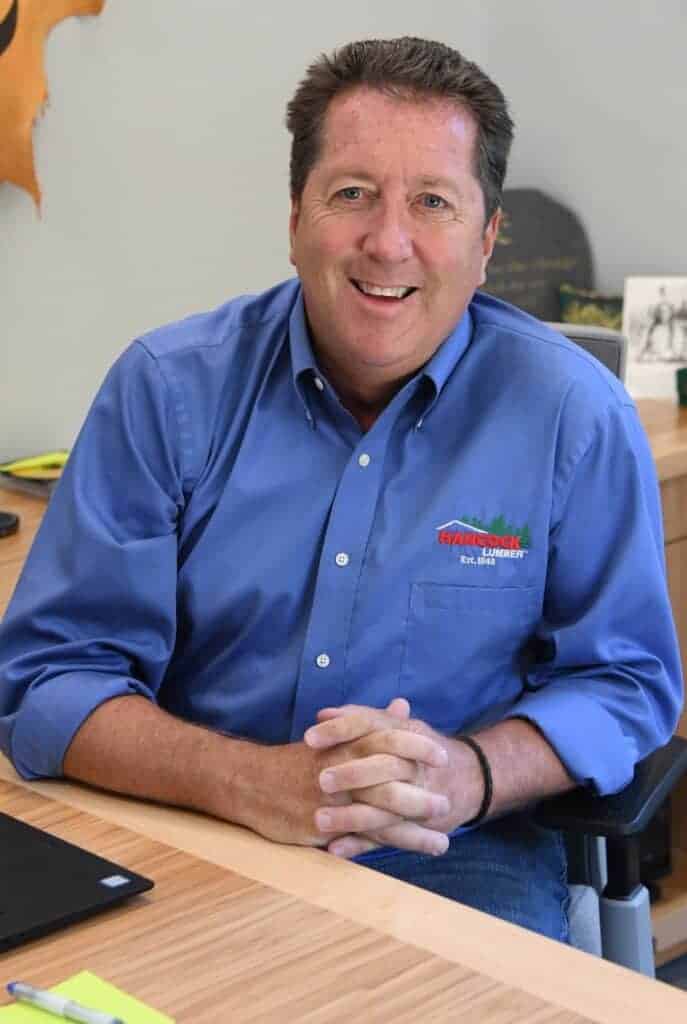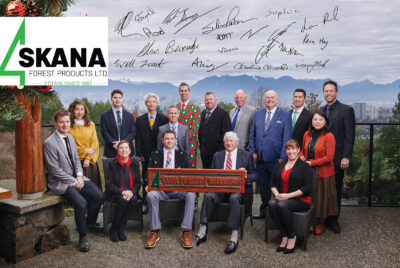
Hancock Lumber, Casco, ME
(The Softwood Forest Products Buyer is reaching out to company leaders across the industry to solicit their input on key issues that impact overall business success. In this publication, Kevin Hancock shares his insights.)
Established in 1848, Hancock Lumber is a seventh-generation, family-owned business whose mission is to create a workplace environment that enhances the lives of the people who work at the organization. Today the company manages over 12,000 acres of their own timberlands, operates three high-efficiency sawmills, truss and wall panel manufacturing facilities, and a network of lumberyards and kitchen design showrooms for professional builders and homeowners looking to make their construction and remodeling projects more innovative, adaptive, and on-demand. Led by their team of nearly 600 employees, Hancock Lumber has been awarded “Best Place to Work in Maine” for seven consecutive years. To learn more, please visit www.HancockLumber.com.
Q. What differentiates companies?
A. It’s generally not products, services, facilities, or equipment. Years ago, I would have said it was the people who make the difference and separate companies. But I have come to realize that’s not the whole story. Certain companies may think they have the ‘best people’, but the truth is, great people are everywhere – the planet is filled with them. For example, the United States has a more productive economy per capita than Europe, but no one would take this to mean that America has better people than Europe does. America is filled with great people, and so is Europe—and, so is every other country on earth. People are inherently great by virtue of their common humanity.
Q. So, if products don’t make the difference, and great people are everywhere, then what separates one organization from another?
A. The answer is culture. Culture makes the difference. An organization’s culture either creates an environment where great people can flourish, or an environment where people are frustrated, held back, or stymied. The culture of an organization either disperses or collects power. This is a choice that the leaders make either overtly or indirectly. During my time on the Pine Ridge Indian Reservation I came to understand that ‘In nature, power is dispersed’. Humans, who are a part of nature – not above it – ultimately aspire to organize in accordance with this sacred natural law. A pathway for corporate and social change starts by helping every employee feel trusted, respected, valued, and heard.
Q. What makes one corporate culture different from another?
A. To me, it’s all about control and where it lives. Some organizations collect leadership power into the bureaucratic center, where a few people can make the majority of the decisions for the many. This is the traditional model of business—and government—leadership and, during a period of time in human history, this may have been optimal. But, that time has passed.
In the 21st century, organizations that disperse power, share leadership, and give everyone a voice are going to win because they recognize and celebrate the capabilities of everyone on the team. These types of cultures don’t see employees as expendable commodities whose purpose is to serve the company. In fact, these types of cultures flip the traditional script by recognizing that the company exists to serve the people who work there. In a great company, profit is an outcome of a higher calling. That higher calling is the celebration of the human spirit and human capacity. In this way, culture makes all the difference. This is why culture is so important to us at Hancock Lumber. We want our company to be a place where every person on the team is trusted, valued, respected, and heard. Work should serve the people who do it in more than just economic ways. Work should be a place where humans flourish—where people learn, lead, and grow. If the employees of a company have an exceptional experience, they will ensure that customers thrive and will protect and grow their company with loyalty and pride. Culture, it turns out, makes the difference. Great people are everywhere, but great cultures aren’t – that’s what separates one company from another.
Effective leadership is about giving away power, not collecting it. Great leaders make others stronger. A decade ago, I acquired a rare voice disorder called spasmodic dysphonia. Suddenly speaking became extremely difficult at times and I was forced to do less of it. As a CEO, my voice was my primary work tool so not having consistent access to it was transformative. In time, however, I came to see my voice limitations as a blessing and an invitation to strengthen the voices of others. This led me to become an advocate of creating a work culture where power was dispersed, leadership was shared, and every voice was trusted, respected, and heard. The organizational structure of human society was long ago designed to compel us to look EXTERNALLY for direction, solutions, leadership, and control. This has been an intentional exercise and has produced an empire-centric view of our world. Employees exist to serve their company, followers, their church, and citizens, their state. These institutions have done some good through their centralization of power but they have also done some bad. Regardless, in virtually all cases, the common denominator is that the individual is advertently made small before the capital, the kingdom, and the crown. True power, we’ve been taught, lives “out there,” beyond our reach.
I’m interested in flipping that script. The goal is not to eliminate human institutions but rather to refocus them on dispersing power, not collecting it. The salvation we seek requires looking inward. The real power source of humanity lives dispersed and WITHIN us all. Each of us is a spark of divine light, a never-to-be-repeated gift. Institutions should exist to celebrate and accelerate self-actualization at an individual level. A great company, therefore, should serve, honor, and ignite the talents of the people who work there.
Hancock Lumber’s mission is to create a work environment that first and foremost recognizes employees as human beings and ultimately improves the lives of anyone who works at the organization. Leadership is encouraged at every position in the company. We strive to create a workplace where employees feel empowered, respected and listened to, honoring our commitment to a culture where ‘Everybody Leads’ which fosters high levels of engagement and a best place to work environment.
Creating and sustaining a best place to work environment takes focus, discipline and a commitment from everyone on the team. Annually, we take a company-wide, third-party administered engagement survey. For the last seven years, our scores have earned us a spot on the “Best Places to Work in Maine” list. What does earning best places to work in Maine mean to Team Hancock? Awards and accolades are always a nice form of recognition and validation, but that has never been our primary objective in participating. For us, the value of this survey—and number one reason why we take it annually— has been to gather honest employee feedback. Hearing directly from nearly all employees (95%!) gives us a collective overview of each person’s voice on the team. Every year we’ve been able to take important steps in building a strong culture where the work experience matters.
Some of the action steps we have implemented based on our Best Places to Work survey results include: revamped and relaunched a new mentor program, new lunchrooms and break areas in many facilities, updated workspaces to reduce noise and increase privacy, digital communication boards with HLTV screens, all employees have a Hancock email address and many devices have been deployed for improved connectivity, huddle systems developed for increased communication, formalized awards and recognition programs, photo rosters and digital announcements of new hires, spirit of cooperation promoted across work groups and locations, a performance gold bonus plan for every employee, annual pay increases and competitive starting wages, and much more. On top of that, our employees have become the #1 most effective recruitment tool for new hires. Our internal employee referral program pays out a $1,000 incentive to employees who recommend a candidate that is successfully hired and stays on board for at least a year. In the last eight years, we’ve paid out over $130,000 to employees who have referred candidates!
Culture exists within an organization whether you decide to work on it or not. It’s up to an organization whether they leverage it as part of their competitive advantage and differentiator in the marketplace. If you’re interested in hearing more from me on these topics, join me on an idea sharing adventure by signing up for my email series in 2021. This year’s series of writings are designed to advance self-actualization and promote respect for all voices—you can sign up on my website: TheBusinessofSharedLeadership.com.
My latest book, 48 Whispers, and series of online essays are dedicated to the advancement of my one central question, “What if everyone on Earth felt trusted, respected, valued, and heard?”
What might change?
I think it could be everything.






